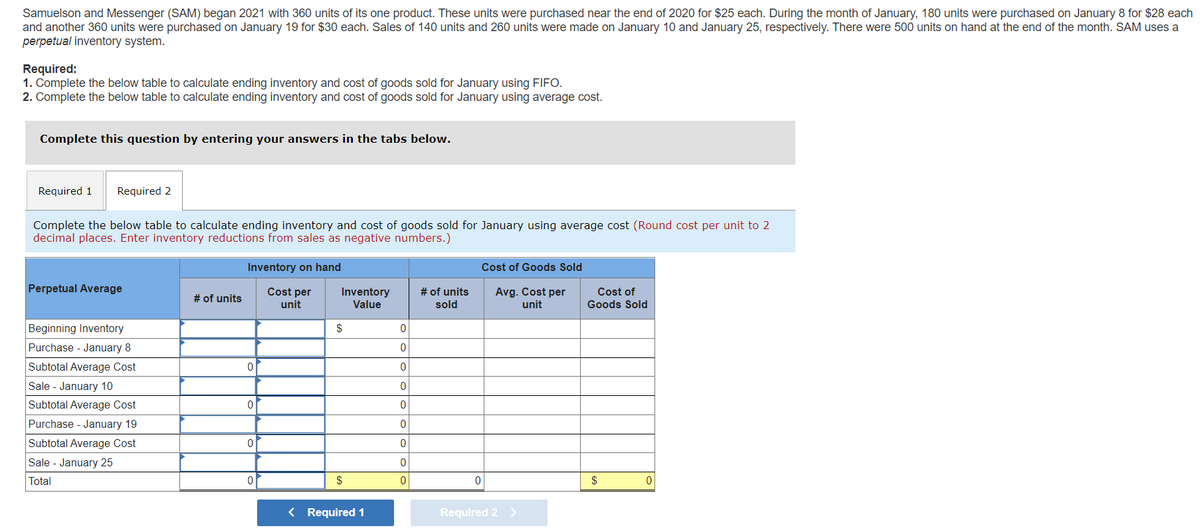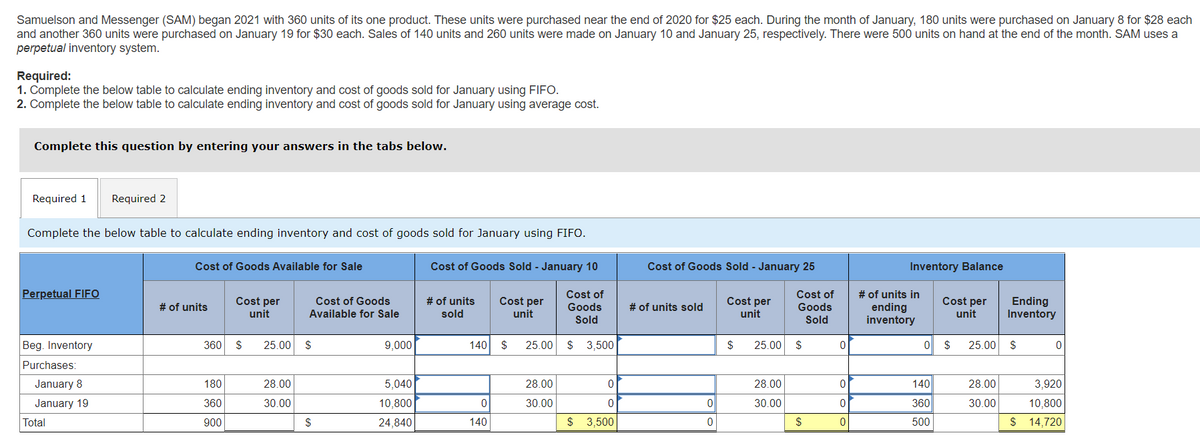Samuelson and Messenger (SAM) began 2021 with 360 units of its one product. These units were purchased near the end of 2020 for $25 each. During the month of January, 180 units were purchased on January 8 for $28 each and another 360 units were purchased on January 19 for $30 each. Sales of 140 units and 260 units were made on January 10 and January 25, respectively. There were 500 units on hand at the end of the month. SAM uses a perpetual inventory system. Required: 1. Complete the below table to calculate ending inventory and cost of goods sold for January using FIFO. 2. Complete the below table t calculate ending inventory and cost of goods sold for January using average cost. Complete this question by entering your answers in the tabs below.
Samuelson and Messenger (SAM) began 2021 with 360 units of its one product. These units were purchased near the end of 2020 for $25 each. During the month of January, 180 units were purchased on January 8 for $28 each and another 360 units were purchased on January 19 for $30 each. Sales of 140 units and 260 units were made on January 10 and January 25, respectively. There were 500 units on hand at the end of the month. SAM uses a perpetual inventory system. Required: 1. Complete the below table to calculate ending inventory and cost of goods sold for January using FIFO. 2. Complete the below table t calculate ending inventory and cost of goods sold for January using average cost. Complete this question by entering your answers in the tabs below.
Cornerstones of Cost Management (Cornerstones Series)
4th Edition
ISBN:9781305970663
Author:Don R. Hansen, Maryanne M. Mowen
Publisher:Don R. Hansen, Maryanne M. Mowen
Chapter20: Inventory Management: Economic Order Quantity, Jit, And The Theory Of Constraints
Section: Chapter Questions
Problem 7E: Ottis, Inc., uses 640,000 plastic housing units each year in its production of paper shredders. The...
Related questions
Question

Transcribed Image Text:Samuelson and Messenger (SAM) began 2021 with 360 units of its one product. These units were purchased near the end of 2020 for $25 each. During the month of January, 180 units were purchased on January 8 for $28 each
and another 360 units were purchased on January 19 for $30 each. Sales of 140 units and 260 units were made on January 10 and January 25, respectively. There were 500 units on hand at the end of the month. SAM uses a
perpetual inventory system.
Required:
1. Complete the below table to calculate ending inventory and cost of goods sold for January using FIFO.
2. Complete the below table to calculate ending inventory and cost of goods sold for January using average cost.
Complete this question by entering your answers in the tabs below.
Required 1 Required 2
Complete the below table to calculate ending inventory and cost of goods sold for January using average cost (Round cost per unit to 2
decimal places. Enter inventory reductions from sales as negative numbers.)
Perpetual Average
Beginning Inventory
Purchase - January 8
Subtotal Average Cost
Sale - January 10
Subtotal Average Cost
Purchase - January 19
Subtotal Average Cost
Sale - January 25
Total
# of units
Inventory on hand
Cost per
unit
0
0
0
0
Inventory
Value
$
$
< Required 1
0
0
0
0
0
0
0
0
0
# of units
sold
0
Cost of Goods Sold
Avg. Cost per
unit
Required 2 >
Cost of
Goods Sold
$
0

Transcribed Image Text:Samuelson and Messenger (SAM) began 2021 with 360 units of its one product. These units were purchased near the end of 2020 for $25 each. During the month of January, 180 units were purchased on January 8 for $28 each
and another 360 units were purchased on January 19 for $30 each. Sales of 140 units and 260 units were made on January 10 and January 25, respectively. There were 500 units on hand at the end of the month. SAM uses a
perpetual inventory system.
Required:
1. Complete the below table to calculate ending inventory and cost of goods sold for January using FIFO.
2. Complete the below table to calculate ending inventory and cost of goods sold for January using average cost.
Complete this question by entering your answers in the tabs below.
Required 1 Required 2
Complete the below table to calculate ending inventory and cost of goods sold for January using FIFO.
Perpetual FIFO
Beg. Inventory
Purchases:
January 8
January 19
Total
Cost of Goods Available for Sale
# of units
Cost per
unit
360 S
180
360
900
Cost of Goods
Available for Sale
25.00 $
28.00
30.00
$
9,000
5,040
10,800
24,840
Cost of Goods Sold - January 10
Cost of
Goods
Sold
25.00 $ 3,500
# of units
sold
Cost per
unit
140 $
0
140
28.00
30.00
0
0
$3,500
Cost of Goods Sold - January 25
# of units sold
0
0
Cost per
unit
$
Cost of
Goods
Sold
25.00 $
28.00
30.00
$
0
0
0
0
Inventory Balance
# of units in
ending
inventory
Cost per
unit
140
360
500
0 $ 25.00 $
Ending
Inventory
28.00
30.00
$
0
3,920
10,800
14,720
Expert Solution
This question has been solved!
Explore an expertly crafted, step-by-step solution for a thorough understanding of key concepts.
This is a popular solution!
Trending now
This is a popular solution!
Step by step
Solved in 3 steps

Knowledge Booster
Learn more about
Need a deep-dive on the concept behind this application? Look no further. Learn more about this topic, accounting and related others by exploring similar questions and additional content below.Recommended textbooks for you

Cornerstones of Cost Management (Cornerstones Ser…
Accounting
ISBN:
9781305970663
Author:
Don R. Hansen, Maryanne M. Mowen
Publisher:
Cengage Learning

Managerial Accounting
Accounting
ISBN:
9781337912020
Author:
Carl Warren, Ph.d. Cma William B. Tayler
Publisher:
South-Western College Pub

Financial And Managerial Accounting
Accounting
ISBN:
9781337902663
Author:
WARREN, Carl S.
Publisher:
Cengage Learning,

Cornerstones of Cost Management (Cornerstones Ser…
Accounting
ISBN:
9781305970663
Author:
Don R. Hansen, Maryanne M. Mowen
Publisher:
Cengage Learning

Managerial Accounting
Accounting
ISBN:
9781337912020
Author:
Carl Warren, Ph.d. Cma William B. Tayler
Publisher:
South-Western College Pub

Financial And Managerial Accounting
Accounting
ISBN:
9781337902663
Author:
WARREN, Carl S.
Publisher:
Cengage Learning,

Principles of Accounting Volume 2
Accounting
ISBN:
9781947172609
Author:
OpenStax
Publisher:
OpenStax College

Excel Applications for Accounting Principles
Accounting
ISBN:
9781111581565
Author:
Gaylord N. Smith
Publisher:
Cengage Learning